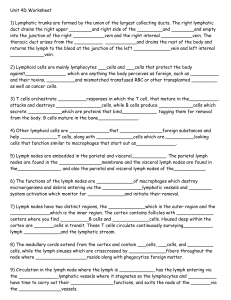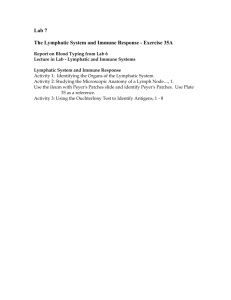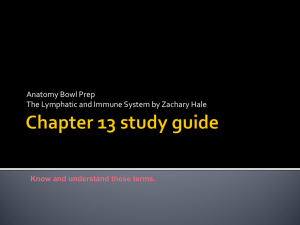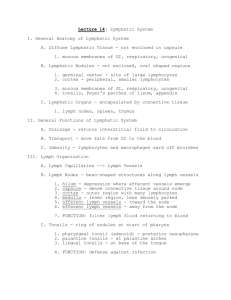Lymphatics
advertisement
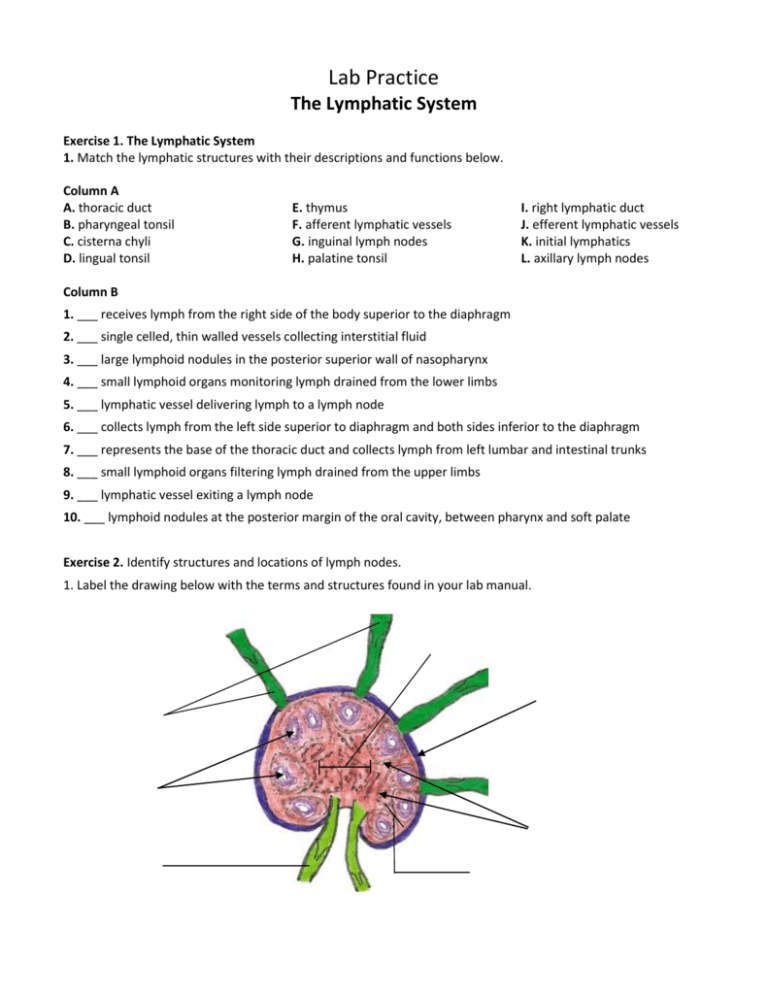
Lab Practice The Lymphatic System Exercise 1. The Lymphatic System 1. Match the lymphatic structures with their descriptions and functions below. Column A A. thoracic duct B. pharyngeal tonsil C. cisterna chyli D. lingual tonsil E. thymus F. afferent lymphatic vessels G. inguinal lymph nodes H. palatine tonsil I. right lymphatic duct J. efferent lymphatic vessels K. initial lymphatics L. axillary lymph nodes Column B 1. ___ receives lymph from the right side of the body superior to the diaphragm 2. ___ single celled, thin walled vessels collecting interstitial fluid 3. ___ large lymphoid nodules in the posterior superior wall of nasopharynx 4. ___ small lymphoid organs monitoring lymph drained from the lower limbs 5. ___ lymphatic vessel delivering lymph to a lymph node 6. ___ collects lymph from the left side superior to diaphragm and both sides inferior to the diaphragm 7. ___ represents the base of the thoracic duct and collects lymph from left lumbar and intestinal trunks 8. ___ small lymphoid organs filtering lymph drained from the upper limbs 9. ___ lymphatic vessel exiting a lymph node 10. ___ lymphoid nodules at the posterior margin of the oral cavity, between pharynx and soft palate Exercise 2. Identify structures and locations of lymph nodes. 1. Label the drawing below with the terms and structures found in your lab manual. 2 2. For the following structures listed below, briefly describe their role and location in the body. 1) Spleen: 2) Thymus: 3) Liver: 4) Lymph Nodes: Which of the structures listed above is not considered part of the lymphatic system? __________________. Why would you not consider this organ part of the lymphatic system? _____________________________________________________________________________________________ 3. Multiple Choice Questions: Select the best answer. 1. Put the following items in the correct order for the pathway of lymph from the stomach to blood. 1) thoracic duct 2) collecting lymphatics 3) initial lymphatics 4) interstitial fluid 5) left subclavian vein 6) lymph nodes: a) 2,3,4,5,1,6 b) 3,6,2,4,1,5 c) 4, 2,1,6,5,3 d) 4, 3, 2, 6, 1, 5 e) 3, 2, 4, 6, 1, 5 2. Which of the following is not a major site of lymphatic tissue? a) tonsils b) thymus gland c) kidneys d) spleen e) collecting lymphatics 3. Which of the following is an important function of the lymphatic system? a) controlling body temperature by evaporation of sweat b) filter and return tissue fluid that has leaked from capillaries c) remove blood from the circulatory system when blood volume gets too large d) producing red blood cells during stressful times e) house progenitors to phagocytic cells to combat infection 4. The spleen a) serves as a storage site for blood platelets b) is an organ in which phagocytosis of aged red blood cells occurs c) is a site of blood formation in the fetus d) collecting lymphatics e) all of the above 5. Both the thoracic duct and the right lymphatic duct empty directly into the a) axillary lymph nodes b) superior vena cava c) subclavian arteries d) junction of the internal jugular and subclavian veins e) brachiocephalic veins 3 4. Lymph Node locations: Below are some of the largest groups of lymph nodes in the body. Next to each one, describe their exact location in the body. Cervical lymph nodes Axillary lymph nodes Supraclavicular lymph nodes Mediastinal lymph nodes Mesenteric lymph nodes Inguinal lymph nodes Femoral lymph nodes Popliteal lymph nodes –



